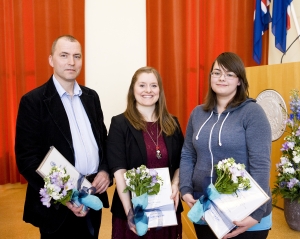In 2013 I got grants from the Watanabe Trust Fund and The Scandinavia-Japan Sasakawa Foundation to travel to Japan. The purpose of the trip was both to research Japanese Manga-artists and their works inspired by Icelandic medieval literature, and to cultivate contacts with Japanese scholars who work within either or both of these fields. After consulting with scholars in Japan, in particular Minoru Ozawa, Assistant Professor at the Rikkyo University in Tokyo, I decided to visit Japan at the end of November and stay there for two weeks.
On Friday November 22, I flew via Copenhagen to Tokyo. I landed in Japan the following morning and it took me most of that day to get settled in at a guest-house of the Rikkyo University, which is in the Ikebukuro district in Tokyo. On November 24, I was adapting to the nine hour time difference and working on the scholarly papers I was going to present during my stay in Japan, but I also met with Sayaka Matsumoto, adjunct at the Kyoto University, who was helping me to plan my stay in Kyoto a few days later.
On November 25, I took part in the conference Old Icelandic Texts in Medieval Northern Europe which Mr. Ozawa had organized at Rikkyo University. There, I met him, Ms. Matsumoto and a number of other Japanese scholars and graduate students working in the field of medieval Scandinavian literature and history. I am happy to report, that my paper at the conference, “The Distributed Authorship of Heimskringla“, will be translated and published in a Japanese scholarly journal in 2014. After the conference, I recorded an interview with Tsukusu Jinn Itó, associate professor at Shinshu University, about Manga inspired by medieval Scandinavian literature, but that is a topic he is specializing in.
On November 26, I visited the Icelandic embassy in Tokyo and had a useful discussion with Ambassador Hannes Heimisson about the ways in which the embassy can support the research of Icelandic culture in Japan. I also visited the Kodansha publishing house and met there with Hiroshi Tada and Akira Kanai, editors at the Afternoon monthly Manga magazine, and with Makoto Yukimura, author of the popular Manga series, Vinland Saga, which is published by Kodansha. I recorded a two hour interview with these men but Yuko Ogawa, who works at the International Rights Department at the company, was our interpreter. That night, I had dinner with Stefan Buchenberger, Associate Professor at Kanagawa University in Yokohama. He is a specialist in international cartoon studies, and had been very helpful in setting up a meeting between me and Norriko Hiraishi, Associate Professor at the University of Tsukuba, a few days later.
On November 27, I had a very useful meeting with Mr. Ozawa. Around noon, I took a train to Kyoto and was welcomed there by Ms. Matsumoto. I spent most of the following day doing research at the International Manga Museum in Kyoto. There I interviewed the museum’s public relations manager, Hiroko Nakamura and Jessica Sugimoto, who is a researcher at the Kyoto University International Manga Research Center. On November 29, I interviewed Ms. Matsumoto but I also gave a paper, “Medieval Sagas as Modern Hypertexts”, at Kyoto University. There, I also met with Professor Dr. Yoshihisa Hattori, Dean of the Graduate School of Letters, and some Japanese students who have been studying in Iceland. The following day, I visited the International Manga Museum again.
I took a train back from Kyoto to Tokyo on December 1 and the following day, I met with Ms. Hiraishi, who is a literary scholar (Manga is one of her primary fields of study). In interviewed her, but she also guided me around the Akihabara district, which is one of the centres of Manga and Anime culture in Tokyo. Ms. Hiraishi and I discussed ways in which some of her research on the reception of Japanese culture in the West might in the future include Iceland. Later that day, I visited a Manga-café in Ikebukoro and a large Manga book-shop close by. On December 3 and December 4, I spent most of my time working in the library of Rikkyo University, but I also visited the largest Manga book-shops in the Shibuya district in Tokyo.
On December 5, I visited the Icelandic embassy in Tokyo again and interviewed one of its staff members, Halldór Elís Ólafsson, who has been living in Japan for the past six years. In the afternoon, I gave a paper at the Kanagawa University on the afterlife of Icelandic medieval literature. After that session, I had dinner with Mr. Buchenberger, Mr. Ozawa and Mr. Itó. On December 6, I flew back from Tokyo to Reykjavík, again via Copenhagen.
As can be seen from the above, my trip to Japan was exceptionally fruitful and inspiring for my research. In the next few months, I will be writing scholarly papers and chapters on the topics that I was researching, but I am also planning to produce a radio program, using the interviews that I took in Tokyo and Kyoto. I will also develop the valuable friendships and professional contacts that were formed during my trip. I would like to use this opportunity and express my deepest gratitude to the Watanabe Trust Fund and The Scandinavia-Japan Sasakawa Foundation for making this trip possible. It will have a permanent influence on my scholarly career and hopefully strengthen cultural contacts between Iceland and Japan.
Jón Karl Helgason, Professor, Faculty of Icelandic and Comparative Cultural Studies

